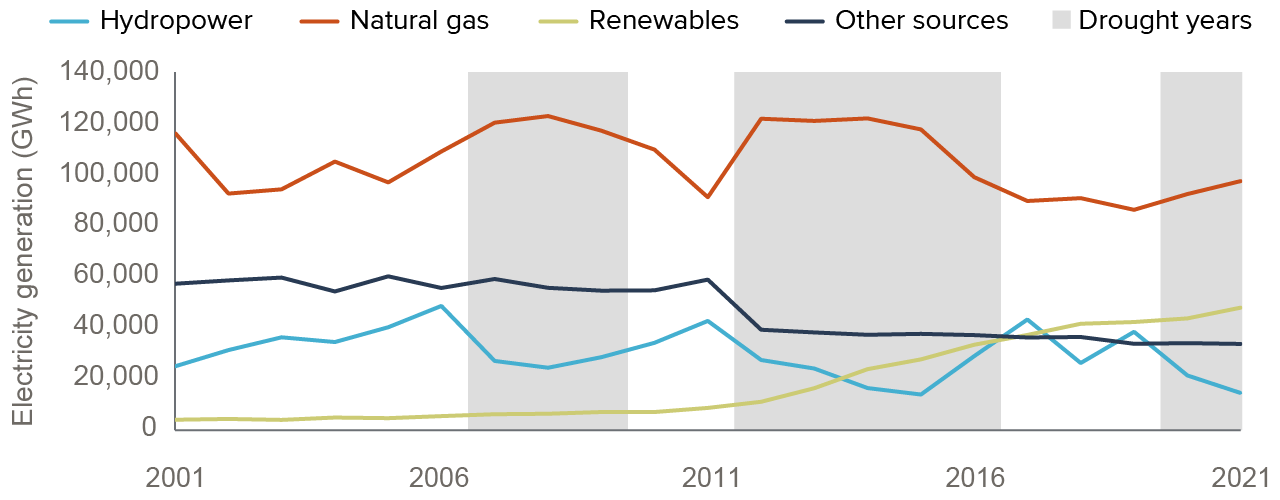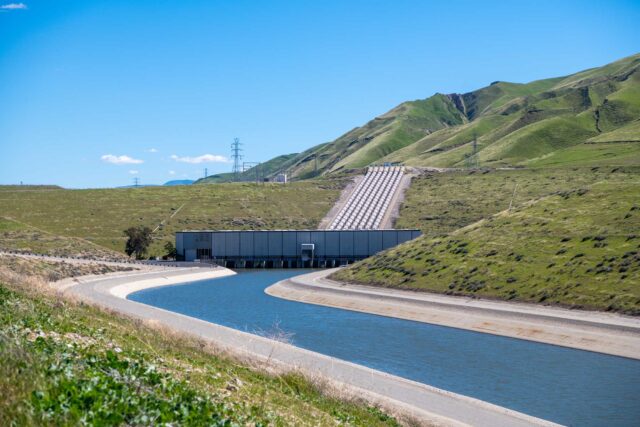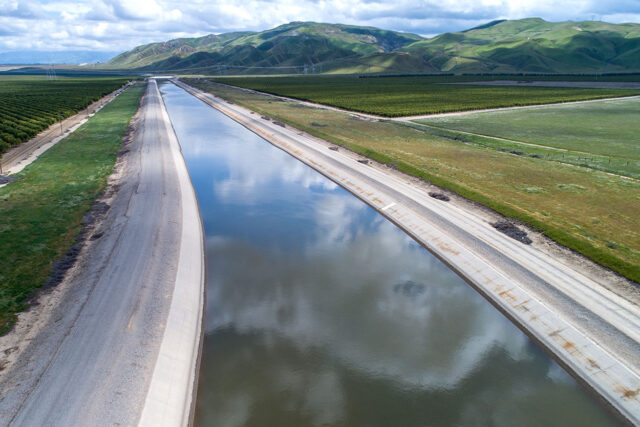In California, water and energy use are closely connected
- California’s water system uses energy to pump, convey, treat, and heat water. Although agriculture uses roughly four times more water than cities, cities account for most water-related energy use.
- Water is also required for hydropower generation, thermoelectric power plants, and oil and gas extraction.
- Improving water use efficiency can reduce energy consumption; conversely, improving energy efficiency can reduce impacts on water supply and quality.
California’s water sector is a major energy user
- The water system uses approximately 20% of the state’s electricity and 30% of its natural gas for business and home use, according to data from 2001—accounting for more than 5% of California’s greenhouse gas emissions.
- Heating and other energy-intensive water uses in homes and businesses make up almost 90% of water-related energy use, while treatment, pumping, and conveyance of water and wastewater account for the rest.
- Because a quarter of total residential energy is used to heat water, reducing hot water use and improving water-heating efficiency could significantly decrease overall energy consumption.
Most energy use by California’s water sector occurs in homes and businesses

SOURCES: California Public Utilities Commission, Embedded Energy in Water Studies. Study 1: Statewide and Regional Water-Energy Relationship (prepared by GEI Consultants/Navigant Consulting, Inc., 2010).
NOTES: The figure shows total energy use by California’s water sector—175,950 gigawatts per hour (GWh). It includes water-related electricity (29% of the total) and natural gas (71%), converted to equivalent measures, for 2001—the last year for which end-use estimates are available. Given population growth and likely increases in demands for water heating since 2001, total water-related energy use may have increased. Conveyance includes the energy used in the California State Water Project, the Central Valley Project, the Colorado River Aqueduct, and several regional water systems. Groundwater pumping is for urban and farm uses. Agricultural end uses include irrigation management, such as pressurization. Residential end uses include energy for heating water and running appliances. End uses do not include the embedded energy for supplying or treating water, which are included in the water operations category.
Energy needs for conveying and pumping water vary greatly
- Surface water conveyance relies on gravity in most places, but sometimes pumping is necessary. Water pumped to Southern California from the north and the Colorado River is especially energy-intensive.
- Pumping provides groundwater to farms and cities, and helps maintain desired pressures in water networks. Energy use varies with groundwater levels and topography; pumping during drought lowers water levels and raises energy use.
- Many urban agencies are investing in alternative water supplies, including recycled wastewater, stormwater capture, and desalination. Though energy-intensive, they generally require less energy than imports in Southern California.
Saving water can be an effective way to save energy
- Reducing urban water use can save energy: during the last drought, water conservation led to substantial energy savings. This can increase the overall benefit of water conservation programs.
- Per-capita urban water use has been declining since the mid-1990s—and more significantly since the 2012–16 drought. Some recent water savings are likely to persist.
California’s energy sector is becoming less water-intensive
- Hydropower averages 15% of California’s electricity generation, from 7% in dry years to over 20% in wet years. Increased precipitation variability due to climate change may reduce hydropower potential.
- Thermoelectric plants may face shortages during droughts, but many California plants have been increasing water efficiency and switching to recycled water for cooling. Some use ocean water, which is drought proof.
- The growth of solar and wind power can boost the electricity sector’s drought resilience by minimizing water use. Innovative approaches like installing solar panels over canals can produce power while reducing evaporation.
California’s electricity mix is sensitive to droughts, but renewables are reducing its water dependence

SOURCE: California Energy Commission.
NOTES: Hydropower includes both small and large hydropower facilities. Renewables include solar photovoltaic, solar thermal, and wind power generation. Other sources include coal, petroleum coke, biomass, geothermal, nuclear, waster heat, and oil.
Utilities can develop policies and technologies that jointly conserve water and energy
- Population growth and climate change will increase pressure on water and energy supplies. Updating the 2001 estimates of water-related energy use could help target further effective actions.
- Policymakers and managers must anticipate the trade-offs of new water and energy technologies. For instance, desalination can improve supply reliability but increase energy loads, while technologies like closed-cycle cooling can benefit aquatic habitat but increase costs and GHG emissions.
- Water and energy providers should work together to assess the costs and benefits of conservation. Reducing household water use can save energy and money, and help decarbonize the economy; utility and state rebates can accelerate such efforts.



